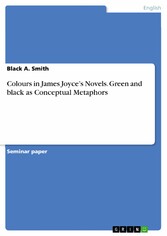Suchen und Finden

Colours in James Joyce's Novels. Green and black as Conceptual Metaphors
Seminar paper from the year 2021 in the subject English Language and Literature Studies - Other, grade: 2,0, University of Osnabrück (Sprachwissenschaft), course: Communication and cognition, language: English, abstract: My paper analyses emotions, positive and negative metaphorical references of colours. The analysis considers Lakoff's and Johnson's conceptual metaphor theory. This approach allows to move out the metaphor outside of the framework of the language system and allows linguists to consider it a phenomenon of interaction of language, thinking and culture. It aims to answer the question of Stephen's and Joyce's relationship to Ireland and the importance of metaphorical concepts in literature. In modern cognitology, metaphor is one of the main mental operations to structure, explain and learn about the world around us. No piece of fiction can be complete without metaphors - stylistic devices and the result of artistic thoughts connected with the poetic vision of the surrounding world. Poetic creativity is defined through characteristic metaphors and poets understand and accept such definitions. Philosophers use metaphors to convey thoughts to readers simplifying them with the help of metaphors connecting them with reality and everyday life. Poets and writers use metaphors to create subtext. This gives their works a unique status of universality, independence from the period of time it was written in and the respective era. It allows many generations of readers to read and comprehend their texts. Lakoff singles out the conceptual metaphors, in other words, figurative models with the help of which we create and perceive the surrounding world. In other words, any sphere of life can be represented as a series of pictures which are firmly established in our minds. The same happens in literature, when an author, creating his work, simultaneously creates his own world - a definite one, unlike any other. By dentifying the figurative models on the basis of which the work is built, it is easier to understand or theorise what the author wanted to tell. It can be confirmed by linguistic data, in particular, by lexis. Thanks to language, we have gained access to metaphors that structure perception, thinking and actions. In literature, colours and emotions are frequently used to describe protagonist's character traits, communicate the narrator's and the author's emotional state. Such features are integrated into the text to build a specific ambience. James Joyce describes emotions and attitudes with colours and emotions in relation to colours in his works. Therefore, Dubliners and A Portrait of the Artist as a Young Man are full of colours and natural imagery.
Alle Preise verstehen sich inklusive der gesetzlichen MwSt.






